Kodungallur
| Kodungallur Muziris | |
|---|---|
| Municipal town | |
 Dutch East India Company ships in Kodungallur (1708) | |
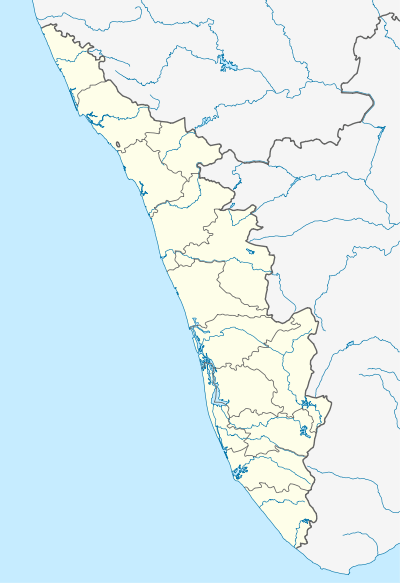 Kodungallur  Kodungallur | |
| Coordinates: 10°14′02″N 76°11′41″E / 10.233761°N 76.194634°ECoordinates: 10°14′02″N 76°11′41″E / 10.233761°N 76.194634°E | |
| Country | India |
| State | Kerala |
| District | Thrissur |
| Government | |
| • Body | Kodungallur Municipality |
| Area | |
| • Total | 40.62 km2 (15.68 sq mi) |
| Elevation | 9 m (30 ft) |
| Population (2011) | |
| • Total | 94,883 |
| • Density | 2,300/km2 (6,000/sq mi) |
| Languages | |
| • Official | Malayalam · English |
| • Spoken languages | Malayalam |
| Time zone | UTC+5:30 (IST) |
| PIN | 680664 |
| Telephone code | 0480 |
| Vehicle registration | KL-8 / KL 47 |
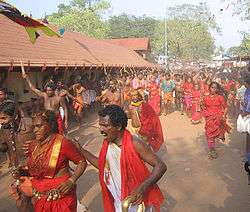
Kodungallur (anglicised name: Cranganore), is a municipality in the South Western border of Thrissur district of Kerala, India. Kodungallur is 29 kilometres (18 mi) northwest of Kochi and 38 kilometres (24 mi) southwest of Thrissur, by National Highway 66. The region is specially important in the history of India as a major trade centre popularly known as Muziris in the erstwhile Chera country.
History of Kodungallur
It is postulated that the ancient city of Muziris (Muchiripattinam, Mahodayapuram/Vanchi, Koti-lingapuram, Kodum Kolai oor) was devastated by natural calamities—a flood or an earthquake—in 1341, and consequently lost its commercial importance thereafter.[1] Further, it came under attack on various occasions: in 1504 by the Portuguese-Kochi allied forces during their movement against Calicut in 1524, by the Mappilas during their attack against the Portuguese, and in 1565 again by the Portuguese.
Etymology
Historically, Kodungallur has been identified as Mahodaya Puram, Mahavanchimana Pattanam, Thrikulasekarapuram, Jangli, Gingaleh, Cyngilin, Shinkali, Chinkli, Jinkali, Shenkala, and Cynkali, which are all derived from the name of the River Changala (or the Chain river, i.e., Shrinkhala in Sanskrit), a tributary of Periyar.[2]
Chera period
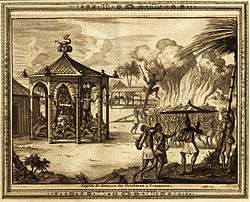
Kodungallur was an integral part of Mahodayapuram, the capital city of the Later Chera dynasty.[3]
The Roman empire had a continuous trading connection with this region. Along with pepper, commodities such as pearls, muslin, ivory, diamonds, silk and perfumes were exported using the maritime facilities of Kodungallur. Sulaiman, an Arab visitor to Mahodayapuram during this period, recorded the economic prosperity of the region and also testified to the high morals kept by its people. Also, he describes the Chinese traders in the city; they are described as purchasing articles such as pepper, cinnamon, ivory, pearls, cotton fabrics and teak wood, while selling fishing nets, silk and porcelain goods.[4]
In the 11th century, Mahodayapuram (Now it is known as Kandanad) was captured by Rajendra Chola I of Chola dynasty. For the next few centuries, Kodungallur was a principality, named Padinjattedathu Swaroopam, under the control of a royal family, Kodungallur Kovilakam, allied either to kingdom of Cochin or to Calicut.[3] Muziris is supposed to be destroyed by massive flooding of Periyar in the 14th century and consequently, the trade got diverted to other ancient ports of the Malabar coast, such as Kochi.[5]
The tradition of Thomas the Apostle
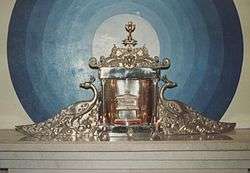
Traditional belief of Saint Thomas Christians of Kerala is that Thomas the Apostle landed in or around Kodungallur[6] in the middle of the 1st century and founded Seven Churches, or Ezharapallikal: Kodungallur, Niranam, Nilackal (Chayal), Kokkamangalam, Kottakkavu, Palayoor (Chattukulangara) and Thiruvithamcode Arappally – a "half church".[7][8][9] According to one view, a Cochin Jew colony in Malabar Coast (later named Anjuvannam near Kodungallur), probably established before the 6th century BC, attracted the Apostle to this region.[10]
Cheraman Juma Masjid
The tradition holds that Cheraman Juma Masjid in Kodungallur, built in 629 AD by Mālik bin Dīnār, is the oldest mosque in India and the second oldest mosque in the world to offer Jumu'ah prayers.[11][12][13] Constructed during the lifetime of Muhammad, the bodies of some of his original followers are said to be buried there.[14] Unlike other mosques in the region that face westwards this mosque faces east. The legend has it that a group of Muhammad's Ṣaḥāba (companions) visited Kodungallur. An unknown Chera dynasty ruler had witnessed a miraculous happening — the sudden splitting of the moon, the celebrated miracle of Muhammad — and learned on inquiry that this was a symbol of the coming of a Messenger of God from Arabia. Soon after, the Chera ruler traveled to Makkah, where he embraced Islam, and accepted the name "Tajuddin". On his way back to India he died at Salalah in Oman. On his deathbed he is said to have authorised some of his Arab companions to go back to his kingdom to spread Islam. Accordingly, a group of Arabs led by Mālik bin Dīnār and Mālik bin Habib arrived in northern Chera kingdom and constructed the Cheraman Juma Masjid at Kodungalloor.[12][15][16]

Colonial period
During Portuguese period, Kodungallur was a tributary state in the kingdom of Zamorin, the most powerful of independent rulers of Malabar region. Since the location of Kodungallur sandwiched between the kingdom of Zamorin and the kingdom of Kochi, it was often a matter of dispute for both the kings and sometimes the chieftain of Kodungallur switched the allegiance.[18] Portuguese landed in Calicut in 1498 and soon they reached in an agreement with the Zamorin for establishing their trade with his subjects and also to open a factory in Calicut. Nonetheless, Portuguese forces tried to establish monopoly in spice trade using violent methods against the Arabs and other Muslim merchants from the Middle East, who had a longstanding loyal relation with the Zamorin.[19] In fact, encouraged by foreign Muslims afraid of losing their monopoly on the spice trade (that also benefited the Venetians) Calicut was the only independent state in the Indian Ocean region at that time to militarily meet the Portuguese transgressions in the region, whereas Kochi opted to ally with the foreign Christians to contain the aggression of the Zamorin.[18]
Zamorin's period
The tussle between Zamorin and Portuguese, though started arising in 1500, broke into the form of a regional war in 1504.[18] Portuguese forces extended their attack on Calicut to allied coastal states, including Kodungallur. The town was almost completely destroyed by the Portuguese (Suarez de Menezes) on 1 September 1504.[20]
Kodungallur, being a port city at the northern end of the Vembanad lagoon, was a strategic entry point for Zamorin's army and fleet into the Kerala backwaters. Hence, in October 1504 Zamorin dispatched a force to fortify Kodungallur. Reading this movement as a preparation for a renewed attack on Kochi, the Portuguese commander, Lopo Soares, ordered a preemptive strike. A squadron of around ten fighting ships, accompanied with numerous fighting boats of Kochi, headed up to Kodungallur. The heavier ships, unable to make their way into the shallow channels, anchored at Palliport (Pallipuram, on the outer edge of Vypin island), while smaller frigates progressed to the destination.
Converging on Kodungallur, the Portuguese-Kochi fleet quickly dispersed the Calicut forces on the beach using cannon, and launched their composite army – some 1,000 Portuguese soldiers and 1,000 Nair warriors of Kochi – who took on the rest of the enemy force in Kodungallur.[21] The assault troops captured and sacked the city of Kodungallur, and was set on fire by the squads led by Duarte Pacheco Pereira and Diogo Fernandes Correa. Nonetheless, according to some records, Portuguese arsonists spared the Saint Thomas Christian quarters in the city. (At the time the community was in a tenuous position: though thriving in the spice trade and protected by their own militia, the local political sphere was volatile and the Saint Thomas Christians had found themselves under pressure from the rajas of Calicut, Cochin and other small kingdoms in the area. Hence the community had sought an alliance with the Portuguese newcomers. Since they were one of the major suppliers of pepper in the region, Portuguese also found the relation as reciprocating.[22]) This might have helped the ancient Christian community of Kodungallur from extinction during the 1504 assault on the city.
Calicut fleet
The Calicut fleet, some five ships and 80 paraus, that had been dispatched to save the city was intercepted by the idling Portuguese ships near Palliport and defeated in a naval encounter.[23] In the meantime, the raja of the Kingdom of Tanur (Vettattnad), whose kingdom lay to the north, on the road between Calicut and Kodungallur, who had a spoiled relation with the Zamorin, offered to place himself under Portuguese suzerainty. It is recorded that the military of Calicut, which was led by Zamorin in person, was defeated on their way to Kodungallur by a sizeable Portuguese army with the assistance of the Tanur ruler.
The raid on Cranganore and the defection of the Tanur raja were serious setbacks to the Zamorin of Calicut, pushing the frontline north and effectively placing the Vembanad lagoon out of the Zamorin's reach. The battle set the scene for Portuguese to expand their colonial authority over a significant area of the Malabar coast. By 1510, their fluid power in the Malabar coast solidified into a perceptible territorial entity.[18]
In 1662, the Dutch entered the competition, sacked the Portuguese in a fortnightly war, with the help of Zamorin, and occupied Kodungallur.[24] The Dutch took the control of Kodungallur fort in 1663 and it eventually protected the southern Kerala, especially Travancore, from the Mysorean invasion in 1776. In 1786, Mysorean troops again marched to northern Kerala, but failed to progress ahead of Kodungallur. On 31 July 1789, the Dutch handed over their establishments in Kodungallur and Azhikode to the Kingdom of Travancore for 300,000 Surat silver rupees.[25]
Recent history
The glory of Kodungallur, as a global trade centre, is believed to be destroyed by natural calamities.[1] According to one view it was heavy floods in the river Periyar that destroyed the city in 1341, while others point out to an earth quake in this regard. The floods further split the left branch of the river into two, just before the city of Aluva. The flood silted the right branch (known as River Changala) and the natural harbour at the mouth of the river to make it poorly navigable for large ships. The misfortune of Kodungallur helped other major ports of Malabar coast, such as the one at Kochi to rise to prominence.[26] Kodungallur was a part of Princely state of Cochin till it joined Indian Union on July 1, 1949.
Archaeology
Until the 1980s, it was generally believed that Kodungallur and Muziris were synonymous from the historical point of view. In 1983, a large hoard of Roman coins was excavated at a site in a small town, called Pattanam, about six miles from Kodungallur. Now this location is one of the most significant archaeological sites in South Asia. The excavations carried out at Pattanam from 2007 to 2011 have uncovered a plethora of archaeologically important materials: over 20,000 articles have now been recovered including terracotta objects, beads, amphora pieces, cannonballs and four skeletons.[27] It has prompted many historians to hypothesize Pattanam as the location of Muziris.[28][29][30][31]
Kodungallur fort
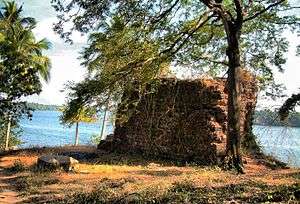
Cranganore Fort, also known as Kottappuram/Kottapuram Fort, was built by Portuguese in 1523 and later in 1565 it was enlarged.[6] The fort was named as Fortaleza Sao Tome, by the Portuguese. The Dutch took possession of the fort in 1663. The remains of the fort show that the original fort wall was 18 feet in thickness. The ruin is also known as Tipu's fort.[32]
Muziris Heritage Project
A project, named Muziris Heritage Project, was launched by the Department of Cultural Affairs, Kerala in 2006 to scientifically retrieve and preserve the historical heritage of the region, extending from North Paravur to Kodungallur. The project envisages a combination of heritage management initiatives in its restoration, conservation and access to the public. Kerala Council for Historical Research (KCHR), identified as the nodal agency for Muziris Heritage Project, provides academic guidance and undertakes archaeological and historical research in the region.[33] The first phase of Muziris Heritage Project was opened to the nation by HE the president of India Shri. Pranab Mukharjee on 27 February 2016 at Kodungalloor.

The area contains several historical and religious sites of note:
- The apostle St Thomas is believed to have landed in Kodungallur in 52 A.D. He established Mar Thoma Syro-Malabar Catholic Church, which is believed to be the first Christian church in India. It still houses ancient relics which are displayed to visitors at certain times.[34]
- Thiruvanchikulam Mahadeva Temple is one of the oldest Shiva temples in South India, where Lord Shiva is said to have lived along with his whole family. This temple has a relation to Tamil Nadu's famous Chidambaram temple. This temple has another rare event called "Anayottam" (elephant race) which is part of the annual festival. Lord Shiva of the Thiruvanchikulam temple is the family god of Cochin Royal Family (Perumpadapu Swaroopam). Thiruvanchikulam temple has the oldest reference in history in old Tamil Sangam literature, well before Malayalam was formed.
- Edavilangu sivakrishnapuram Temple is one of the oldest temples in Kodungallur. It is currently under the Cochin Devaswom Board, but is now looked after by the devotees of Edavilangu. Here, Lord Siva and Krishna are the main idols.
- Cranganore Fort, also known as Kodungallur Fort, was built by the Portuguese in 1523. The Dutch took possession of it in 1661[6] and later it came under the control of Tipu Sultan. The ruin is also known as Tipu Sultan’s fort. The fort is about 2 km from the town of Kodungallur.[35]
- Chirakkal Kovilakam is the palace of Royal Family of Kodungallur. Kodungallur was an autonomous principality subordinate to the Raja of Cochin[6] until India's Independence in 1947. Puthen Kovilakam, a well-known centre of learning, is attached to this palace.
Demographics
As of 2011 India census,[36] Kodungallur municipality had a population of 94,883: males constitute 47% of the population and females 53%, while 10% of the total population was under 6 years of age. The municipality had an average literacy rate of 85%: male literacy is 85.58% and female literacy is 85.00%.
Local government
Kodungallur Municipality was formed in the year 1978. It had 28 wards till November 11, 2009 when Methala was added to Kodungallur Municipality which now makes up an area of 40.62 km2 and 44 electoral wards. The Municipality has a total population of 94,883 with a density of 1,806 per km2 as per the 2011 Census. Kodungallur is the headquarters of the Kodungallur Taluk and is a Grade-II Municipality. [37] Kodungallur assembly constituency is part of Chalakudi (Lok Sabha constituency).[38]
Transport
Kodungallur is well connected to other towns and cities through Road Network. KSRTC kodungallur Sub Depot operates buses to almost every parts of Kerala. Kodungallur does not have a Railway Station, since it is situated away from railway line. Aluva railway station in Ernakulam District (28 km) is the major railway station near Kodungallur.
Nearby towns and cities
- Kochi (29 km)
- Chalakudy(26 km)
- Angamaly(28 km)
- North Paravur (11 km)
- Aluva (28 km)
- Irinjalakuda (17 km)
- Thrissur (39 km)
- Guruvayur (50 km)
- Thriprayar (25.1 km)
Notable people
- Rulers of Chera dynasty
- Vel Kelu Kuttuvan Kadal Pirakottiya Cheran Chenguttavan
- Kulashekhara Alwar
- Ilango Adigal
- Śaṅkaranārāyaṇa Mathematician/ Astronomer
- Kodungallur Kunjikkuttan Thampuran
- P. Bhaskaran
- Bahadoor
- Kamal (director) Film Director
- T.M. Thomas Isaac
See also
References
- 1 2 Ashis Nandy (1 January 2002). Time Warps: Silent and Evasive Pasts in Indian Politics and Religion. Hurst. pp. 172–. ISBN 978-1-85065-479-7. Retrieved 28 August 2012.
- ↑ For a large number of such names for Kodungallir down the centuries arranged more or less chronologically cf. K. P. Padbhanabha Menon, History of Kerala Vol. I, quoted by George Menachery in Kodungallur, 1987, reprinted 2000.
- 1 2 A Sreedhara Menon (1 January 2007). A Survey Of Kerala History. DC Books. p. 126. ISBN 978-81-264-1578-6. Retrieved 22 August 2012.
- ↑ A Sreedhara Menon (1 January 2007). A Survey Of Kerala History. DC Books. p. 127. ISBN 978-81-264-1578-6. Retrieved 22 August 2012.
- ↑ "History of Kochi". Centre For Heritage Studies, India. Archived from the original on 15 September 2015. Retrieved 2010-09-05.
- 1 2 3 4

- ↑ James Arampulickal (1994). The pastoral care of the Syro-Malabar Catholic migrants. Oriental Institute of Religious Studies, India Publications. p. 40.
- ↑ Orientalia christiana periodica: Commentaril de re orientali ...: Volumes 17–18. Pontificium Institutum Orientalium Studiorum. 1951. p. 233.
- ↑ Adrian Hastings (15 August 2000). A World History of Christianity. Wm. B. Eerdmans. p. 149. ISBN 978-0-8028-4875-8.
- ↑ Abraham Mattam (Mar)) (2001). Forgotten East: Mission, Liturgy and Spirituality of the Eastern Churches : a Study with Special Reference to the Church of St. Thomas Christians. Ephrem's Publications. p. 148. ISBN 978-81-88065-00-4.
- ↑ Dan Landis; Rosita D. Albert (14 February 2012). Handbook of Ethnic Conflict: International Perspectives. Springer. p. 141. ISBN 978-1-4614-0447-7. Retrieved 22 August 2012.
- 1 2 "World's second oldest mosque is in India". Bahrain tribune. Archived from the original on 6 July 2006. Retrieved 2006-08-09.
- ↑ Cheraman Juma Masjid A Secular Heritage
- ↑ "A mosque from a Hindu king". indiatravels. Retrieved 2006-08-09.
- ↑ "Hindu patron of Muslim heritage site". iosworld.org. Retrieved 2006-08-09.
- ↑ "Kalam to visit oldest mosque in sub-continent". Chennai, India: The Hindu. 23 July 2005. Retrieved 2006-08-09.
- ↑ Anjana Singh (30 April 2010). Fort Cochin in Kerala, 1750-1830: The Social Condition of a Dutch Community in an Indian Milieu. BRILL. p. 233. ISBN 978-90-04-16816-9. Retrieved 29 August 2012.
- 1 2 3 4 Pius Malekandathil (2010). Maritime India: Trade, Religion and Polity in the Indian Ocean. Primus Books. pp. 90–. ISBN 978-93-80607-01-6. Retrieved 23 August 2012.
- ↑ Sanjay Subrahmanyam (29 October 1998). The Career and Legend of Vasco Da Gama. Cambridge University Press. pp. 293–294. ISBN 978-0-521-64629-1. Retrieved 26 July 2012.
- ↑ Yosef Kaplan (2008). The Dutch Intersection: The Jews and the Netherlands in Modern History. BRILL. p. 65. ISBN 978-90-04-14996-0. Retrieved 23 August 2012.
- ↑ Castanheda, p.272
- ↑ Frykenberg, Eric (2008). Christianity in India: from Beginnings to the Present, 122–124. Oxford University Press. ISBN 0-19-826377-5.
- ↑ Mathew (1997: p.14)
- ↑ K. K. Kusuman (1987). A History of Trade & Commerce in Travancore, 1600–1805. Mittal Publications. ISBN 978-81-7099-026-0. Retrieved 28 August 2012.
- ↑ Anjana Singh (30 April 2010). Fort Cochin in Kerala, 1750-1830: The Social Condition of a Dutch Community in an Indian Milieu. BRILL. pp. 86, 149, 158. ISBN 978-90-04-16816-9. Retrieved 28 August 2012.
- ↑ A Sreedhara Menon (1 January 2007). A Survey Of Kerala History. DC Books. p. 18. ISBN 978-81-264-1578-6. Retrieved 22 August 2012.
- ↑ "Largest book on Archaeological findings". The Times of India. 21 December 2011.
- ↑ "Search for India's ancient city". BBC News. 11 June 2006. Retrieved 2010-05-19.
- ↑ http://www.hinduonnet.com/2004/03/23/stories/2004032303340500.htm
- ↑ "Hunting for Muziris". The Hindu. Chennai, India. 28 March 2004.
- ↑ "Excavations highlight Malabar maritime heritage". The Hindu. Chennai, India. 1 April 2007.
- ↑ "Kottappuram fort". muzirisheritage.org. Kerala Tourism Department. Retrieved 24 August 2012.
- ↑ Kerala Council for Historical Research
- ↑ Menachery,Kodungallur...1987, reprint 2000
- ↑ "Kodungallur". Kerala Tourism. Retrieved 2010-10-15.
- ↑ "Census of India 2001: Data from the 2011 Census, including cities, villages and towns (Provisional)". Census Commission of India. Archived from the original on 2004-06-16. Retrieved 2008-11-01.
- ↑ "Profile". Janasevana Kendram. Archived from the original on 24 March 2011. Retrieved 2010-12-07.
- ↑ "Assembly Constituencies – Corresponding Districts and Parliamentary Constituencies" (PDF). Kerala. Election Commission of India. Archived from the original (PDF) on 4 March 2009. Retrieved 2008-10-19.
External links
| Wikimedia Commons has media related to Kodungallur. |
| Wikisource has the text of the 1911 Encyclopædia Britannica article Kodungalur. |
